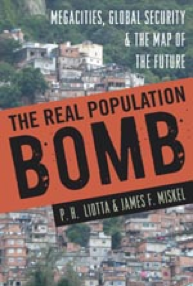 Review by Howard Cincotta
Review by Howard Cincotta
The Real Population Bomb: Megacities, Global Security and The Map of the Future by P.H. Liotta and James F. Miskel, Potomac Books: Dulles, Virginia, ISBN 978-1-59797-551-3 (hardcover), ISBN 978-1-61234-107-1 (electronic), 2012, 250 pp., $19.97 hardcover, $16.47 Kindle/Nook editions.
Quick — which of the following constitutes the gravest threat to security of the United States and the global community generally: A) China, B) terrorism, C) global warming, D) Lagos? For the authors of The Real Population Bomb, the answer isn’t even close: D.
From their perspective, the explosive growth of the world’s megacities — Cairo and Karachi, Lagos and Rio de Janeiro — “will pose the most significant security threat in the coming decade.” Poet and writer P.H. Liotta, a member of the U.N. Intergovernmental Panel on Climate Change, and security analyst James Miskel, who served on the National Security Council, provide eye-popping statistics and grim firsthand reportage to back their assertion that the “entangled vulnerabilities” of these basically uncontrolled and often uncontrollable urban centers constitute a global reality that we ignore at our peril. The greater danger isn’t failed states, it’s failed cities.
The numbers are staggering. In 1950, only one city had more than 10 million inhabitants: New York. By 2025, according to the United Nations, there will be at least 27. Liotta and Miskel focus largely on nine of the most vulnerable of those cities – Cairo, Mumbai, Dhaka, Karachi, Lahore, Lagos, Kinshasa, Nairobi, and Rio de Janeiro – all “located in states that have largely proven incapable of providing the scale of law enforcement, public health, education, and social services that such large populations require.”
The consequence, they argue, is a malignant stew of corruption, poverty, violence, religious extremism, and insecurity that spawns criminal gangs beyond the reach of the law, harbors terrorists with both local and transnational ambitions, destabilizes struggling national governments, threatens international trade (notably oil), and causes vast environmental degradation.
Liotta and Miskel offer a pungent quote from George Orwell: “This squalid brawl in a distant city is more important than it might first appear.” They then pose an ominous scenario in which these masses, “in their collective rage, despair, and hunger will inevitably erupt … they will leave — those that can — bringing violence with them.”
When the book turns from its tone of imminent threat to a city-by-city examination, however, something interesting happens. The explicit threat to national security — hordes at the barricades — becomes more diffuse and nuanced, the slow-motion human catastrophe comes into even sharper focus, and the book becomes a lot more compelling.
All of the cities profiled share the common denominators of poverty, corruption, violence, and vast, nominally illegal squatter settlements, whether Rio’s favelas or Mumbai’s johpadpatti. But in many other important ways, they are very different. For reasons of history, culture, and economics, for example, the prospects for Cairo (national capital, strategic importance, cultural weight) and Rio de Janeiro (rising economy, strong national government, coming of the Olympics) appear far more favorable than those for Karachi (jihadist violence, ethnic conflict, weakening national fabric) and Dhaka (projected population of 23 million by 2015, still the world’s fastest growing megacity, facing horrific environmental challenges). A violent failing city like Karachi — “R-and-R haven” for the Taliban — constitutes a far more immediate security threat than the abyss of Kinshasa, where the poor are so far from any hope of city services or protection that many have retreated to shamanism and cults, including a belief in the flying broomsticks and witchcraft of the Harry Potter movies.
Liotta and Miskel frame their analysis in a security context, but with minor tweaks, they could easily have subtitled their book along the lines of “The Vast Humanitarian Disaster of the World’s Megacities.” These urban leviathans, after all, with their tableaus of human misery, are not a looming prospect, but a present reality that has been with us for some time. On the other hand, national security remains the prudent choice: that’s where the money is.
It would be unfair to expect Liotta’s and Miskel’s policy ideas to match the range and urgency of their urban portraits of despair, dysfunction, and yes, resilience and hope. At the same time, it’s apparent that their proposals, while realistic and entirely feasible, hardly reach their own standard for “urgent, collective, and innovative actions.”
The exception is a proposal to establish “charter cities” — in effect to have the international community take over municipal operations of failing cities, much as Michigan took over the Detroit public schools. International charter cities are a bold idea that deserves a chapter of its own, in my view, yet the authors offer it in an almost apologetic manner, as if already ducking to avoid the brickbats of outrage (“Violate national sovereignty!”) or patronizing realism (“Where will the money come from?”). But let them jeer: at least the charter city idea would be part of the discussion. I haven’t the faintest idea if such a concept is remotely feasible, but I’d like to witness the debate. If nothing else, Liotta and Miskel have sounded a powerful call for big creative ideas to address a global issue of the first magnitude.
It’s hard to imagine Brazil or Pakistan ever agreeing to anything like a charter city, but would Nigeria or the Democratic Republic of the Congo reject, in principle, the possibility of an international takeover of water, sanitation, power, and policing in Lagos and Kinshasa? (Liotta and Miskel point out that the 2016 Olympics coming to Rio de Janeiro has already resulted in positive changes. Maybe the Olympic Games should be repurposed as a humanitarian/development enterprise. 2020 Mumbai or 2024 Nairobi, anyone?)
The Real Population Bomb offers fertile ground for debate and disagreements in the specifics, but its overarching point is unassailable: megacities are a phenomenon of such importance that they reframe the debate away from the familiar dichotomies of the North-South divide, or nation-states vs. individual human rights. We are indeed entering an overwhelming urban world of “entangled vulnerabilities.”
Attention must be paid.![]()
American Diplomacy is the Publication of Origin for this work. Permission to republish is freely granted with credit and a link back to American Diplomacy

